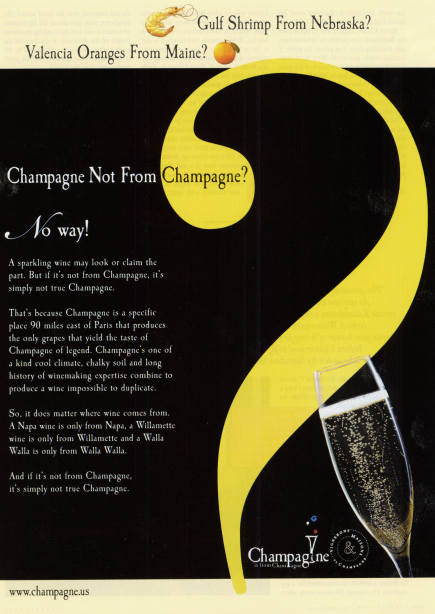Ads that Reinforce Geographic Indicators Have their Limitations

The Vignerons & Maisons of Champagne run an ad each month in Vanity Fair reminding readers that Champagne only comes from Champagne, France. The crux of the message is the bubbly stuff we drink from Napa is merely “sparkling” wine. Ads like this can work for wine because they are backed by precisely-defined appellations. Washington, for example, has nine federally-recognized American Viticultural Areas. That means if a wine does not come from grapes grown in the 6,000 acres due south of Mabton (to the west) and Pasco (to the east), it does not come from Washington’s Horse Heaven Hills.
It’s trickier for other home-grown favorites. Take oysters, for example. For the most part, Washington oysters are all the same species, namely, Crassostrea gigas, or Pacific oysters. But try finding “Pacific oyster” on the menu next time you’re at a seafood restaurant. In all likelihood, you can order Pacific oysters, but you’ll find them identified solely by locale: Puget Sound, Hood Canal, or Grays Harbor. Or, even more likely, by the micro-areas within these regions, like Penn Cove, Skookum, Westcott Bay, Windy Point, Totten Inlet, or Hog Island. In Washington, at least, these areas are not legally defined.
This presents a recurring problem for Seattle-area trademark lawyers. If a grower harvests oysters three miles due east of Penn Cove, in the Saratoga Passage, can it market them as “Penn Cove” oysters? What if its oyster seed came from Penn Cove but was transplanted and harvested in Hood Canal? What if its oysters share the characteristics of oysters grown in Penn Cove but actually come from somewhere far away? Could the hypothetical Penn Cove Oyster Co. successfully argue that PENN COVE refers exclusively to the oysters it sells? (To date, no one has registered PENN COVE as a trademark with the U.S. Patent and Trademark Office in connection with shellfish, but someday that may change.)
These are largely factual questions that an advertising campaign is not likely to solve. The Champagne ad belies this limitation. It rhetorically asks: “Gulf shrimp from Nebraska?” and “Valencia oranges from Maine?” Clearly, “Gulf” shrimp doesn’t come from Nebraska and “Valencia” oranges don’t come from Maine. But where exactly do those products come from? I suspect that Valencia orange growers and New Orleans shrimpers struggle with these issues as much as our oyster harvesters do. I won’t even ask exactly where Washington’s “Walla Walla Sweet” onions come from.
Reader Comments (2)
Many shippers on the east coast cannot get sufficient supplies of locally grown oysters and are buying oysters from the Gulf of Mexico which can be leagally retagged and sold without mention of origin.
While it may be uncommon currently to actually trademark the oyster itself it clearly seems appropriate for the markerter to brand his reputation on quality, consistancy and purity of an oyster.